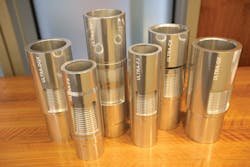Building a stronger pipe company
Dmitry Aleksandrovitch Pumpyanskiy, Chairman of TMk | Interview
Russia's TMK is the largest steel pipe producer in the world with the widest range of pipe products.
Focus Reports,Exclusive to OGFJ
OIL & GAS FINANCIAL JOURNAL: The vast majority of TMK's business is based in Russia, a country that currently has a 14.1% share of all the oil and gas drilling activity in the world. This makes Russia a great market for TMK. However, the market is not expected to grow dramatically in the short term. What strategies do you sense for the Russian market: expansion, or an improvement of the profit per tonne in Russia?
DMITRY PUMPYANSKIY: TMK is currently Russia's leading steel pipe producer: the company's market share is about 27% of all steel pipe consumption in the country. In accordance with our strategy, around 75% of our total sales were made to the oil and gas industry, which shows strong demand in the areas of hydrocarbon production and transportation.
When we started TMK in 2001, the idea was to create a leader for the Russian steel pipe industry. The company soon acquired four of the seven major Russian pipe plants. Since that time, however, we have grown way beyond Russian borders to service the global oil and gas industry. Today we have the widest range of pipe products in the world, from tiny stainless steel needles to 2.5m diameter water pipes. We specialize in pipes for exploration, drilling, and production, as well as transportation of hydrocarbons, keeping the main focus on seamless OCTG pipes. Our total pipe capacity is 6.5 million tonnes per year worldwide. Last year, our output was 4.22 million tonnes, making us the largest steel pipe producer in the world, for the fourth year in a row. In order to maintain the leadership, we have invested more than $3 billion USD in the modernization and renovation of our Russian, American, and European plants.
Today, TMK sells its products to more than 80 countries and has production sites in seven with around half of its sales generated outside of Russia. The current plan is to increase shipments of high value-added products, such as heat-treated and high-alloyed pipe, as well as to expand premium connections and other oil and gas services offerings.
OGFJ: Is there such a large demand in Russia for high value-added products, or do you need to generate this demand yourself?
DP: We first developed our premium offering, both in pipe and connections, and then educated the end-user customer as to its performance and cost advantages when you consider the costs from spudding the well to connection to the gathering line or trunkline.
In some cases our Russian customers ask to be supplied with these products because of the challenging and harsh environmental conditions they are working under in new projects, such as Arctic and offshore exploration. Premium quality pipe helps these companies to guarantee reliable production. For example, we have a strong demand from Gazprom for such products, and we have been working with them for over 12 years under a bilateral R&D agreement, which is renewed every five years in order to accommodate new targets for seamless and large diameter pipe. Joint R&D agreements such as this one help both developing our high added-value offering and understanding the technical needs of Russian super majors.
OGFJ: Many key suppliers argue that the Russian oil and gas and transport majors are able to place a lot of price pressure on their suppliers, given their bargaining power. How are you able to supply premium products under such conditions?
DP: This is a matter of the way you provide your products, the demand that a particular customer has for them, and how well you can sell the advantages of your premium products to him. One of the ways that TMK can tackle this last challenge is to offer the full range of pipes to its clients, for everything they need, from drilling to large diameter pipes. I do not agree with you, however, that the prices on the Russian market are that bad. One of the things that keep prices positive for us are long-term supply contracts, which bring benefits both to us and to our partners.
OGFJ: Given the solidity of your business in Russia, how do you assess the potential to expand the business downstream in order to become more of a service provider to the oil and gas industry as an OFS company?
DP: This is absolutely part of our strategy. When we started in this business, we had just four facilities. Today, we are a globally competitive pipe maker, using modern technologies and expanding our footprint to include additional smaller finishing plants, which are integrated under sub-holding servicing companies. Using these small production sites to build a service offering for our customers, we have managed not only to improve relationships with our clients but also to increase our operational efficiency and to create incremental value for our business.
The various services on offer to the oil and gas industry encompass a very large and diverse spectrum. We have six production sites on this service side in Russia and several more worldwide, including the US, which produce downhole equipment as well as different accessories alongside our pipe portfolio, such as drilling joints and couplings. They also manufacture gas cylinders and hydraulic equipment. We are also offering pipe coating, maintenance and repair services. All of these production sites are located close to the operations of our customers, which allows us to provide supervisory service at their wells. There is a lot of competition in this area, but we are working hard to convince our customers to choose TMK.
OGFJ: Working in the Russian market can be extremely demanding, given the size of the market and the additional political side of the oil and gas industry. Given this, how did you find your drive, and the time, to internationalize TMK?
DP: From the inception of the company, we were aiming at developing an international business. We had to change many things, including corporate culture. This helped us launching an IPO in 2006. In 2008, we acquired 10 US pipe plants, which gave us an opportunity to enter the world's biggest oil and gas market as a domestic player. Since then we have developed this business further. Today, TMK IPSCO is the third-largest producer of pipes for the oil and gas industry in North America, with 11 production sites in the US and one in Canada.
OGFJ: How was the culture shock for Americans being acquired by a "Russian company?"
DP: There was no "shock." Having integrated our US plants into the TMK system, we improved their planning, supply chain, and technical policy. Today, our US and Russian technical teams work together as one unit. We built our own R&D center in Houston and eventually moved our US headquarters there. Our American colleagues tell us that they are glad to be in a company that is committed to pipe and tube for the long term. Of course we had to learn, too. For example, marketing and sales in the US have their specialty. While we discuss all technical issues, R&D, and strategic planning with end-users, with US-based oil and gas clients, pipe is sold through distributors, which is a lot different from selling to our big clients in Russia. However, we have seen similar market structure in other countries, so we adjusted quickly. The bottom line is: we are extremely pleased with our North American operations and colleagues.
OGFJ: In past interviews, you have mentioned your interest in developing pipes for shale gas, and the challenge that it poses because of the different materials and technologies used. To what extent will you be able to apply your experiences and efforts put in the field of shale gas developments around the world and in Russia, where shale gas has not brought with it the same excitement as in other parts of the world?
DP: We have successfully built up our ULTRA-premium connections business through demand generated in the US by shale gas projects where we have a 30% market share at some shale gas plays. Now we have started selling our US-developed ULTRA threads in Russia, where demand for premium connections recently was increasing by 20% to 30% a year. This synergy works both ways. Being the leader in Russian premium connection market by having developed Russian TMK-Premium connections, we start actively promoting these on the US and Canadian markets.
OGFJ: Last year TMK acquired a controlling stake in the GIPI pipe plant in Oman and established a service joint venture in Abu Dhabi. Generally speaking, don't you find the MENA region overcrowded and oversupplied, where TMK may look like a late-comer?
DP: This was not our first experience in the Middle East. We previously supplied our pipe products to almost all the national oil companies in the Gulf region, North Africa, and the Middle East from our Russian plants. As a result, we understand this market very well. The Middle East division was the fourth to be established at TMK after the Russian, US, and European divisions. We feel it is important not just to be seen as a trading partner, but also an industrial partner in the region. We believe we are a "right-time comer" in the Middle East.
OGFJ: Do you feel that the volume sold in these countries by TMK will increase?
DP: We made the acquisition in order to achieve that goal. The TMK GIPI plant was built in 2010. It is very modern and can produce welded pipes from 8" to 24" in diameter. The facility can produce both line pipe and OCTG, and we have already tested our premium connections threading there. The capacity of the plant is around 250,000 tonnes, which we should reach in the near future.
OGFJ: Certainly you would like to continue your international expansion and growth. Will your $3.7 billion USD debt hold you back from achieving these objectives?
DP: TMK's debt level is something we watch very carefully. We have worked hard for the last three years with our creditors in order to improve its structure. For example, we issued three Eurobonds for almost $1.5 billion, which fixed income investors liked a lot. We used the proceeds to replace short-term debt and push our debt maturity into long-term. For the moment, our short-term debt stands at about 13%, with most of the debt portfolio due in five to seven years.
In order to further reduce our debt level, we aim to increase our efficiency across the board, while simultaneously lowering costs. We will still consider limited acquisitions where there are synergies with our existing business, such as the one we recently completed in the US to form a service company OFSi, which will complement our existing business very well, adding to our global network of oil and gas finishing services and premium connections.
OGFJ: Today TMK is valuated at a 15% discount versus top peer value. Given your strategy, how long do you think it will take before TMK is perceived and valued at the same level as its top global competitors?
DP: Improving our performance is the key to catching up with our global competitors. We know how to manage our discrepancies. Across the company and in all our markets, we are moving our products to the right in complexity and upwards in profitability. We are going in the right direction. In today's difficult environment, we show competitive operational results compatible with our position in the global top three.
A thorough analysis is needed to perform such benchmarking. Higher revenue per tonne may not necessarily mean better product, it may simply reflect higher revenue from services, which have no tonnes behind them. And when this higher revenue per tonne number goes in parallel with higher costs per tonne, it may bring little advantage in terms of margins, which we could recently see comparing TMK with some of its global peers.
On the positive side, if investors realize TMK's strong market position and other competitive advantages, existing discount that you mentioned could be a very good opportunity for them to make money.
OGFJ: On June 25, TMK held its annual general meeting of shareholders in Moscow. Can you share with our readers the major highlights from the meeting, the satisfaction levels of the shareholders, and the changes the company will be making during the next fiscal period?
DP: The focus of the shareholder meeting was on the results of 2012, which is very much in the past for us. While we always look towards the future, we view the annual meeting as a good opportunity to meet with our shareholders and share the final conclusions from the previous year.
There was nothing particularly unusual. Shareholders approved the annual report and elected the board of directors for the coming year, including five independent board members. We also fulfilled all other necessary legal requirements. The shareholders also voted to approve the dividends for the year. TMK's policy is to pay not less than 25% of IFRS net profit in dividends.
OGFJ: Given the size and scope of your business activities, I'm sure the company is stronger in some areas than in others. Where would you like to see TMK improve?
DP: We would like to develop our core business, which is the seamless pipe business for the oil and gas sector, and we will concentrate on premium products and other high value-added products. This is the strategy we aim to follow in all markets where TMK has a presence. We will also develop our oil and gas service offering, while continuing to supply our customers with the best quality product. Finally, we will continue to be in the large diameter pipe business in Russia.
OGFJ: Do you have a final message to the readers of Oil & Gas Financial Journal, particularly those in the US?
DP: We will continue to be a reliable partner for our US customers. We will strive to increase their satisfaction with our pipe products and services. We will enhance our relationships by offering more oil field services for our customers in the US, through OFSi.
We also value our US shareholders, which are the largest group of financial investors holding our stock.
OGFJ: Thanks very much for your time, Dmitry Aleksandrovitch.



